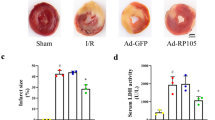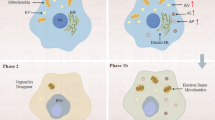Abstract
The aim of the present study was to assess whether the protective effects of ischemic preconditioning (PC) are associated with activation of the mitochondrial ATP-sensitive potassium channels (mitoKATP) and if there is any relationship between the activity of these channels and the mitochondrial permeability transition pore (MPTP) opening in ischemic-reperfused rat hearts under different nutritional conditions. Langendorff-perfused hearts of fed and 24-h fasted rats were exposed to 25 min of no-flow global ischemia plus 30 min of reperfusion. Fasting accelerated functional recovery and attenuated MPTP opening. The mitoKATP blocker, 5-hydroxydecanoic (HD), did not influence functional recovery and MPTP opening induced by ischemia–reperfusion in the fed hearts but partially reversed the beneficial effects of fasting. PC and the mitoKATP opener, diazoxide (DZ), improved functional recovery, preserved cell viability, and inhibited MPTP opening in both fed and fasted hearts. The protection elicited by PC and DZ on contractile recovery and MPTP opening was reversed by HD, which did not affect cell viability. Altogether, these results argue for a role of mitoKATP and its impact on preservation mitochondrial inner membrane permeability as a relevant factor in the improvement of contractile function in the ischemic-reperfused rat heart. They also suggest that the functional protection elicited by PC may be related to this mechanism.





Similar content being viewed by others
Abbreviations
- ANT:
-
Adenine nucleotide transporter
- C:
-
Control
- DMSO:
-
Dimethyl sulfoxide
- DZ:
-
Diazoxide
- HD:
-
5-Hydroxydecanoic
- [3H]-2-DG:
-
2-Deoxy-[3H]-glucose
- mitoKATP:
-
Mitochondrial ATP-sensitive potassium channels
- MPTP:
-
Mitochondrial permeability transition pore
- PC:
-
Ischemic preconditioning
References
Abdallah Y, Wolf C, Meuter K, Piper HM, Reusch HP, Ladilov Y (2010) Preconditioning with diazoxide prevents reoxygenation-induced rigor-type hypercontracture. J Mol Cell Cardiol 48:270–276
Asimakis GK, Inners-McBride K, Medellin G, Conti VR (1992) Ischemic preconditioning attenuates acidosis and postischemic dysfunction in isolated rat heart. Am J Physiol 263:H887–H894
Baines CP (2009) The mitochondrial permeability transition pore and ischemia-reperfusion injury. Basic Res Cardiol 104(2):181–188
Di Lisa F, Semenzato M, Carpi A, Menazza S, Kaludercic N, Menabò R, Canton M (2010) In: Minotti G (ed) Mitochondrial dysfunction in cell injury and cardiotoxicity in cardiotoxicity of non-cardiovascular drugs. Wiley, Chichester, pp 1–23
Facundo HT, de Paula JG, Kowaltowski AJ (2005) Mitochondrial ATP-sensitive K + channels prevent oxidative stress, permeability transition and cell death. J Bioenerg Biomembr 37(2):75–82
Fryer RM, Eells JT, Hsu AK, Henry MM, Gross GJ (2000) Ischemic preconditioning in rats: role of mitochondrial K(ATP) channel in preservation of mitochondrial function. Am J Physiol 278:H305–H312
Fryer RM, Hsu AK, Gross GJ (2001) Mitochondrial K (ATP) channel opening is important during index ischemia and following myocardial reperfusion in ischemic preconditioned rat hearts. J Mol Cell Cardiol 33:31–34
Gabel S, Cross HR, London RE, Steenbergen C, Murphy E (1997) Decreased intracellular pH is not due to the increased H+ extrusion in preconditioned rat hearts. Am J Physiol 273:H2257–H2262
Griffiths EJ, Halestrap AP (1995) Mitochondrial non specific pores remain closed during cardiac ischemia, but open upon reperfusion. Biochem J 307:93–98
Gross GJ, Peart JN (2003) KATP channels and myocardial preconditioning: an update. Am J Physiol Heart Circ Physiol 285:H921–H930
Grover GJ, Murray HN, Baird AJ, Dzwonczyk S (1995) The KATP blocker sodium 5-hydroxydecanoate does not abolish preconditioning in isolated rat hearts. Eur J Pharmacol 277:271–274
Halestrap AP (2009) What is the mitochondrial permeability transition pore? J Mol Cell Cardiol 46(6):821–831
Hausenloy DJ, Ong SB, Yellon DM (2009) The mitochondrial permeability transition pore as a target for preconditioning and postconditioning. Basic Res Cardiol 104:189–202
Jennings RB (2013) Historical perspective on the pathology of myocardial ischemia/reperfusion injury. Circ Res 113:428–438
Kerr PM, Suleiman MS, Halestrap AP (1999) Reversal of permeability transition during recovery of hearts from ischemia and its enhancement by pyruvate. Am J Physiol 276:H496–H502
Korge P, Honda HM, Weiss JN (2002) Protection of cardiac mitochondria by diazoxide and protein kinase C: implications for ischemic preconditioning. Proc Natl Acad Sci 299:3312–3317
Liepinsh E, Makrecka M, Kuka J, Makarova E, Vilskersts R, Cirule H, Sevostjanovs E, Grinberga S, Pugovics O, Dambrova M (2014) The heart is better protected against myocardial infarction in the fed state compared to the fasted state. Metab Clin Exp 63:127–136
Marina Prendes MG, Rastelli AH, Astudilla C, Fernández MA, Martínez M, Perazzo JC, Testoni G, Savino EA, Varela A (2004) Influence of fasting on the effects of diazoxide in the ischemic-reperfused rat heart. J Physiol Biochem 60:51–58
Marina Prendes MG, González MS, Torresín ME, Hermann R, Pascale NG, Jaitovich MM, Savino EA, Varela A (2009) Involvement of mitochondrial permeability transition, glutathione status, pentose phosphate pathway and oxidative damage in the protective effect of fasting in the ischemic-reperfused rat heart. Clin Exp Pharmacol Physiol 36:637–642
Marina Prendes MG, González MS, Hermann R, Pascale NG, Torresín ME, Jaitovich MM, Savino EA, Varela A (2010) Involvement of the mitochondrial ATP-sensitive potassium channel in the beneficial effects of fasting on the ischaemic-reperfused rat heart. In: Haugen S, Meijer S (eds) Handbook of nutritional biochemistry: genomics, metabolomics and food supply. Nova Science Publishers, United States of America, pp 483–494
Montessuit C, Papageorgiou I, Tardy I, Cantalupi I, Rosenblatt-Velin N, Lerch R (2000) Postischemic recovery of heart metabolism and function: role of mitochondrial fatty acid transfer. J Appl Physiol 89:111–119
Murata M, Akao M, O’Rourke B, Marban E (2001) Mitochondrial ATP sensitive potassium channels attenuate matrix Ca2+ overload during simulated ischemia and reperfusion: possible mechanism of cardioprotection. Circ Res 89:891–898
Ong SB, Gustafsson AS (2012) New roles for mitochondria in cell death in the reperfused myocardium. Cardiovasc Res 94:190–196
O’Rourke B (2004) Evidence of mitochondrial K + channels and their role in cardioprotection. Circ Res 94:420–432
Ramasamy R, Liu H, Cherednichenko G, Schaefer S (2001) Fasting limits the increase in intracellular calcium during ischemia in isolated rat hearts. Basic Res Cardiol 96:463–470
Schaefer S, Ramasamy R (1997) Glycogen utilization and ischemic injury in the isolated rat heart. Cardiovasc Res 35:90–98
Schneider CA, Taegtmeyer H (1991) Fasting in vivo delays myocardial cell damage after brief periods of ischemia in the isolated working rat heart. Circ Res 68:1045–1050
Schultz JE, Qian YZ, Gross GJ, Kukreja RC (1997) The ischemia-selective KATP channel antagonist, 5-hydroxydecanoate, blocks ischemic preconditioning in the rat heart. J Mol Cell Cardiol 29:1055–1060
Schwartz LM, Welch TS, Crago MS (2002) Cardioprotection by multiple preconditioning cycles does not require mitochondrial K(ATP) channels in pigs. Am J Physiol 283:H1538–H1544
Shepherd D, Garland PB (1969) The kinetic properties of citrate synthase from rat liver mitochondria. Biochem J 144:597–599
Sivaraman V, Yellon DM (2014) Pharmacologic therapy that simulates conditioning for cardiac ischemic/reperfusion injury. J Cardiovasc Pharmacol Ther 19:83–96
Sunaga D, Tanno M, Miki T, Kuno A, Kouzu H, Sato T, Ishikawa S, Ogasawara M, Tobisawa T, Miura T (2013) Activation of the mitochondrial ATP-sensitive potassium channel achieves cell protection by promoting re-closure of the mPTP via suppression of GSK-3beta—complex III interaction. Eur Heart J 34:1859
Varanyuwatana P, Halestrap AP (2012) The roles of phosphate and the phosphate carrier in the mitochondrial permeability transition pore. Mitochondrion 12(1):120–125
Varela A, Marina Prendes MG, Testoni G, Vázquez N, Astudilla C, Cerruti S, Savino EA (2002) Influence of fasting on the effects of ischemic preconditioning in the ischemic-reperfused rat heart. Arch Physiol Biochem 110:189–196
Walters AM, Porter GA Jr, Brookes PS (2012) Mitochondria as a drug target in ischemic heart disease and cardiomyopathy. Circ Res 111:1222–1236
Acknowledgments
The authors thank Norma Gladys Infante for the technical assistance. This research was supported in part by grants from Universidad de Buenos Aires and IQUIMEFA-CONICET.
Author information
Authors and Affiliations
Corresponding author
Rights and permissions
About this article
Cite this article
Marina Prendes, M.G., Hermann, R., Torresin, M.E. et al. Role of mitochondrial permeability transition pore and mitochondrial ATP-sensitive potassium channels in the protective effects of ischemic preconditioning in isolated hearts from fed and fasted rats. J Physiol Biochem 70, 791–800 (2014). https://doi.org/10.1007/s13105-014-0347-y
Received:
Accepted:
Published:
Issue Date:
DOI: https://doi.org/10.1007/s13105-014-0347-y




